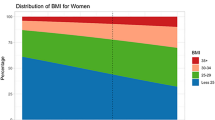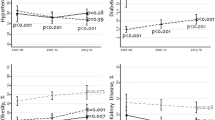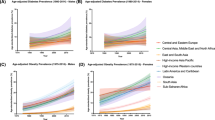Abstract
Introduction
Research on the prevalence of body mass index (BMI) categories across different living arrangements remains limited. We aimed to quantify the prevalence of BMI categories among those living alone (LA) and those not living alone (NLA).
Methods
In this population-based cross-sectional study, we used individual-level data from the 2011–2021 Behavioral Risk Factor Surveillance System. Main outcomes were prevalence of BMI categories in LA and NLA, adjusted for age, gender, and race/ethnicity, and socioeconomic status, using logistic regression and model-predicted marginal prevalence to estimate BMI categories prevalence.
Results
Between 2011 and 2021, we quantified BMI categories prevalence in 4,195,414 adults in the BRFSS, with 1,197,787 (28.5%) adults LA and 2,997,627 (71.5%) adults NLA. In comparison to NLA, LA consistently demonstrates lower adjusted obesity prevalence across genders and age groups, with the highest prevalence observed in the 45–64 age range, particularly within the 45–54 group (LA: 37.4%, 95% CI: 37.1–37.8%; NLA: 34.3%, 95% CI: 33.8–34.7%). Additionally, LA displays an overall lower adjusted prevalence of overweight compared to NLA, notably in the 18–34 and >64 age groups.
Conclusions
Heterogeneity in BMI categories prevalence exists between LA and NLA. Future studies and public health efforts should consider this heterogeneity.
This is a preview of subscription content, access via your institution
Access options
Subscribe to this journal
Receive 12 print issues and online access
$259.00 per year
only $21.58 per issue
Buy this article
- Purchase on Springer Link
- Instant access to full article PDF
Prices may be subject to local taxes which are calculated during checkout


Similar content being viewed by others
Code availability
All codes used in this study can be obtained from the corresponding author upon reasonable request.
References
Esteban O. The rise of living alone: how one-person households are becoming increasingly common around the world. 2019. https://ourworldindata.org/living-alone. Accessed 12 February 26 2023.
Snell K. The rise of living alone and loneliness in history. Soc Hist. 2017;42:2–28. https://doi.org/10.1080/03071022.2017.1256093.
National Bureau of Statistics. https://data.stats.gov.cn/easyquery.htm?cn=C01. Accessed 12 February 26 2023.
Esteve A, Reher D, Treviño R, Zueras P, Turu A. Living alone over the life course: cross‐national variations on an emerging issue. Popul Dev Rev. 2020;46:169–89.
Zhao Y, Guyatt G, Gao Y, Hao Q, Abdullah R, Basmaji J, et al. Living alone and all-cause mortality in community-dwelling adults: a systematic review and meta-analysis. EClinicalMedicine. 2022;54:101677.
Olfson M, Cosgrove CM, Altekruse SF, Wall MM, Blanco C. Living alone and suicide risk in the United States, 2008‒2019. Am J Public Health. 2022;112:1774–82.
Gandhi S, Goodman SG, Greenlaw N, Ford I, McSkimming P, Ferrari R, et al. Living alone and cardiovascular disease outcomes. Heart. 2019;105:1087–95.
Cobb LK, McAdams-DeMarco MA, Gudzune KA, Anderson CA, Demerath E, Woodward M, et al. Changes in body mass index and obesity risk in married couples over 25 years: the ARIC Cohort Study. AM J EPIDEMIOL. 2015;183:435–43.
Lavie CJ, Laddu D, Arena R, Ortega FB, Alpert MA, Kushner RF. Healthy weight and obesity prevention: JACC health promotion series. J am Coll Cardiol. 2018;72:1506–31.
Greenberg H. An inflection point in global public health. Global Health. 2022;18:99 https://doi.org/10.1186/s12992-022-00897-3.
Flegal KM, Graubard BI, Williamson DF, Gail MH. Excess deaths associated with underweight, overweight, and obesity. JAMA J Am Med Assoc. 2005;293:1861–7. https://doi.org/10.1001/jama.293.15.1861.
Kwon H, Yun JM, Park JH, Cho BL, Han K, Joh H-K, et al. Incidence of cardiovascular disease and mortality in underweight individuals. J Cachexia Sarcopenia Muscle. 2021;12:331–8. https://doi.org/10.1002/jcsm.12682.
Wang C, Xu J, Yang L, Xu Y, Zhang X, Bai C, et al. Prevalence and risk factors of chronic obstructive pulmonary disease in China (the China Pulmonary Health [CPH] study): a national cross-sectional study. Lancet. 2018;391:1706–17. https://doi.org/10.1016/S0140-6736(18)30841-9.
Tani Y, Kondo N, Takagi D, Saito M, Hikichi H, Ojima T, et al. Combined effects of eating alone and living alone on unhealthy dietary behaviors, obesity and underweight in older Japanese adults: results of the Jages Appetite. 2015;95. https://doi.org/10.1016/j.appet.2015.06.005.
Hawkley LC, Buecker S, Kaiser T, Luhmann M. Loneliness from young adulthood to old age: explaining age differences in loneliness. Int J Behav Dev. 2022;46:39–49. https://doi.org/10.1177/0165025420971048.
Henning-Smith C, Gonzales G. The relationship between living alone and self-rated health varies by age: evidence from the national health interview survey. J Appl Gerontol. 2020;39:971–80.
Centers for Disease Control and Prevention. https://www.cdc.gov/brfss/annual_data/annual_data.htm. Accessed 12 January 26 2023.
Chinese General Social Survey. http://cgss.ruc.edu.cn/English/Home.htm. Accessed 12 January 26 2023.
European Social Survey European Research Infrastructure (ESS ERIC). (2018). ESS7 - integrated file, edition 2.2 [Data set]. Sikt - Norwegian Agency for Shared Services in Education and Research. https://doi.org/10.21338/ESS7E02_2.
WHO Expert Consultation. Appropriate body-mass index for Asian populations and its implications for policy and intervention strategies. Lancet. 2004;363:157–63.
Mikami Y, Motokawa K, Shirobe M, Edahiro A, Ohara Y, Iwasaki M, et al. Relationship between eating alone and poor appetite using the simplified nutritional appetite questionnaire. Nutrients. 2022;14. https://doi.org/10.3390/nu14020337.
Kim H, Chung J. Associations of the eating alone behavior with nutrient intake, obesity and metabolic syndrome in middle-aged adults based on the 2013 ~ 2017 Korean National Health and Nutrition Examination Survey. J Nutr Health. 2019;52:435. https://doi.org/10.4163/jnh.2019.52.5.435.
Sakurai R, Kawai H, Suzuki H, Kim H, Watanabe Y, et al. Poor social network, not living alone, is associated with incidence of adverse health outcomes in older adults. J Am Med Dir Assoc. 2019;20:1438–43. https://doi.org/10.1016/j.jamda.2019.02.021.
Hanna KL, Collins PF. Relationship between living alone and food and nutrient intake. Nutr Rev. 2015;73. https://doi.org/10.1093/nutrit/nuv024.
Kim J, Noh JW, Park J, Kwon YD. Body mass index and depressive symptoms in older adults: a cross-lagged panel analysis. PLoS One. 2014;9:e114891. https://doi.org/10.1371/journal.pone.0114891.
Garcia A, Higgs S, Lluch A, Darcel N, Davidenko O. Associations between perceived social eating norms and initiation and maintenance of changes in dietary habits during the first COVID-19 lockdown in France. Foods. 2021;10: https://doi.org/10.3390/foods10112745.
Suwalska J, Bogdański P. Social modeling and eating behavior—a narrative review. Nutrients. 2021;13: https://doi.org/10.3390/nu13041209.
Ng M, Fleming T, Robinson M, Thomson B, Graetz N, Margono C, et al. Global, regional, and national prevalence of overweight and obesity in children and adults during 1980–2013: a systematic analysis for the Global Burden of Disease Study 2013. Lancet. 2014; 384:766–81.
Pan XF, Wang L, Pan A. Epidemiology and determinants of obesity in China. Lancet Diabetes Endo. 2021;9. https://doi.org/10.1016/S2213-8587(21)00045-0.
Scholes S, Fat LN, Mindell JS. Trends in cardiovascular disease risk factors by BMI category among adults in England, 2003–2018. Obesity. 2021;29. https://doi.org/10.1002/oby.23184.
Author information
Authors and Affiliations
Contributions
MY designed the study and formulated the research question. YL collected the data. MY and YL analyzed the data and wrote the first draft of the manuscript. All authors approved the final version.
Corresponding author
Ethics declarations
Competing interests
The authors declare no competing interests.
Ethical approval
As this study used secondary data collected from publicly available sources, it was exempt from human subject review by the institutional review boards. Both publicly available BRFSS, CGSS, and ESS data and deidentified, restricted data (obtained under a data use agreement) were used.
Additional information
Publisher’s note Springer Nature remains neutral with regard to jurisdictional claims in published maps and institutional affiliations.
Supplementary information
Rights and permissions
Springer Nature or its licensor (e.g. a society or other partner) holds exclusive rights to this article under a publishing agreement with the author(s) or other rightsholder(s); author self-archiving of the accepted manuscript version of this article is solely governed by the terms of such publishing agreement and applicable law.
About this article
Cite this article
Yan, M., Liu, Y. BMI categories across different living arrangements. Int J Obes 47, 1263–1268 (2023). https://doi.org/10.1038/s41366-023-01381-7
Received:
Revised:
Accepted:
Published:
Issue Date:
DOI: https://doi.org/10.1038/s41366-023-01381-7



